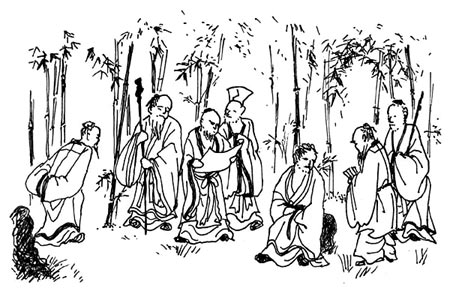|
||
 |
||

@
(C)2001 Japanese Architecture and Art Net Users System.@No reproduction or republication without written permission.
fΪΜeLXgEΚ^ECXgΘΗASΔΜRecΜ³f‘»E]ΪπΦΆά·B
|
||||||
| @ | ||||||
| chikurin shichiken@|Ρ΅« | ||||||
| KEY WORD :@art history / paintings | ||||||
| @ | ||||||
| Ch: Zhulinqixian. Lit. Seven Sages of the Bamboo Grove. A pictorial theme based on seven Chinese literati who, to escape the social chaos of the Wei-Jin period, fled to a secluded bamboo grove chikurin |Ρ where they could express their personalities freely by the enjoyment of pure conversation seidan ΄k, music, and wine. The Seven Sages are: Ruan Ji (Jp: Gen Seki θΠ; 210-263), Ji Kang (Jp: Kei Kou mN; 223-266), Shan Tao (Jp: San Tou R; 205-266), Xiang Xiu (Jp: Kyou Shuu όG; 221-300), Liu Ling (Jp: Ryou Rei «ΰ; ca. 225-280), Wang Rong (Jp: Oujuu €^; 234-305), and, Ruan Xian (Jp: Gen Kan θχ, nephew of Ruan Ji). All were famous for the purity of their reclusive spirits, their strong Taoist and anti-Confucian values, and their strikingly eccentric personalities. The Seven Sages are mentioned in several Chinese texts, most notably Shushuoxinyu (Jp: SESETSU SHINGO ’ΰVκ; ca 5c) or New Specimens of Contemporary Talk. The earliest depiction of the subject is found on a set of late 4c or early 5c clay tomb tiles from the Xishanqiao ΌP΄ area of Nanjing μ. Typical Chinese iconography shows gentlemen playing musical instruments and writing poetry as well as drinking wine. The subject was popular with Japanese painters of the Momoyama and early Edo periods who tended to transform the theme into a rather generalized image of reclusive scholars engaging in literary pursuits. Thus, the Seven Sages theme was often mixed with depictions of the four accomplishments *kinki shoga Υϋζ or paired with the Four Hermits at Mt. Shang Shan *shouzan shikou €Rlα©. Noteworthy examples include works by Kanou Motonobu λμ³M (1476-1559, Tokyo National Museum), Kaihou Yuushou CkFΌ (1533-1615, Kenninji m, Kyoto). Sesson αΊ (act. 16c) took early liberties with the theme, painting his famous "Dancing Seven Sages of the Bamboo Grove" Chikurin shichken butou-zu |Ρ΅«x} (private collection) in 1574. The Seven Sages theme, with its philosophical Chinese overtones and popularity with military and priestly patrons, later became a favorite target for parody pictures *mitate-e ©§ΔG by *ukiyo-e ’G artists substituting beautiful women for the gentlemen. | ||||||
| @ | ||||||
@ |
||||||
@ |
||||||
| REFERENCES: | ||||||
| @ | ||||||
| EXTERNAL LINKS: | ||||||
| @@ | ||||||
| NOTES: | ||||||
| @ | ||||||
(C)2001 Japanese Architecture and Art Net Users System.@No reproduction or republication without written permission. fΪΜeLXgEΚ^ECXgΘΗASΔΜRecΜ³f‘»E]ΪπΦΆά·B |
||||||
| @ |